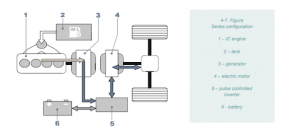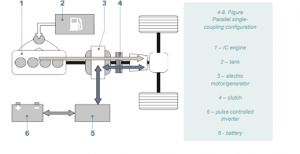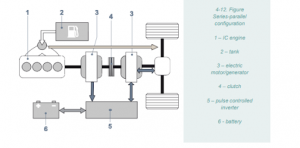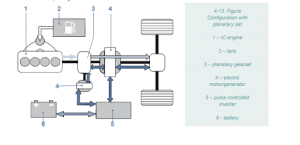Lesson 6: HEV, PHEV hybrid drive structure
In this lesson, we will delve into the intricate world of hybrid drive structures within Hybrid Electric Vehicles (HEV) and Plug-In Hybrid Electric Vehicles (PHEV). We’ll explore the various configurations, including series, parallel, series-parallel, and configurations with planetary gearsets.
- Series Configuration of the Hybrid Drive
In the series configuration of hybrid drive, there is no mechanical connection between the internal combustion engine (IC engine) and the mover. The entire drive is facilitated by an electric motor, which can be powered by either batteries or a generator connected to the IC engine. This electric motor can serve as both the propulsion source and a generator during regenerative braking.
1.1 Operating Modes of Series Hybrid Drive
- Motion using electricity solely from the battery, with the IC engine turned off.
- Motion powered exclusively by the generator connected to the IC engine, with no battery usage.
- Motion utilizing electricity generated by both the IC engine and the battery.
- Simultaneous movement and battery recharging through the IC engine-driven generator.
- Regenerative braking, where the electric motor functions as a generator to convert kinetic energy into electrical energy for battery recharge, with the IC engine off.
- Recharging the battery using energy from the IC engine, not engaging the electric motor.
- Hybrid battery recharging through regenerative braking by the electric motor and IC engine-driven generator.
1.2 Advantages and Disadvantages of Series Configuration
- Efficient operation of the IC engine with maximum efficiency.
- Possibility of using smaller, lighter IC engines.
- Placement flexibility for IC engines and generators.
- No need for complex transmission systems.
- Suitable for urban driving conditions with frequent stops and starts.
- Potential for external power supply to charge batteries, reducing fuel consumption.

Disadvantages:
- Energy transformations result in some losses.
- Requires high-capacity batteries, increasing vehicle weight.
- The presence of a generator adds to the vehicle’s weight and cost.
- Less effective at high speeds and uphill driving due to energy transformation losses.
- Commonly found in larger vehicles like buses and heavy freight vehicles.
- Parallel Hybrid Drive Configuration
In the parallel hybrid drive configuration, both the IC engine and the electric motor are mechanically connected to the drive movers. Typically, the IC engine is the primary power source, with the electric motor providing support in specific driving situations. The electric motor can also act as a generator during regenerative braking.
2.1 Variants of Parallel Hybrid Drive Configuration
- Single-coupling variant with direct connection between the IC engine and electric motor.
- Double-coupling variant allowing for independent operation of the IC engine and electric motor.
- All-wheel drive variant enabling power distribution to individual wheels for torque control.
- Additional generator for all-wheel drive and battery recharge during regenerative braking.
2.2 Advantages and Disadvantages of Parallel Configuration
- Drive realized with lower energy transformations, reducing losses.
- Compact structure with smaller electric motors, suitable for smaller vehicles.
- Relatively simple upgrade of conventional vehicles to hybrids.
Disadvantages:
- Less flexibility in optimizing IC engine operation.
- Complex hybrid system management and power transmission.

- Series-Parallel Hybrid Drive Configuration
Series-parallel hybrids combine the advantages of both series and parallel configurations. They include a mechanical connection between two electric motors, one of which serves as a generator. This hybrid type excels at low speeds but can function as a parallel hybrid at higher speeds.
3.1 Characteristics of Series-Parallel Hybrid Drive Configuration
- Dual energy transformation, mostly at lower speeds.
- Smaller electric motors compared to series hybrids.
- Fuel savings at low to medium speeds.
- Complex power transmission systems and control algorithms.

- Hybrid Drive Configuration with Planetary Gearset
The hybrid drive configuration with a planetary gearset combines series and parallel hybrid features. It utilizes a planetary gearbox to connect the IC engine, generator, and electric motor. This configuration offers flexibility in adjusting IC engine speed, enabling various driving modes.
4.1 Key Characteristics of Planetary Gearset Configuration
- Part of IC engine power converted to electricity via a generator.
- Remainder of power, along with electric motor power, drives the vehicle.
- Exceptional accelerations possible.
- Ideal for urban driving with minimal pollution.
- Complex kinematics and control algorithm, as well as added weight.

Conclusion
- Hybrid electric vehicles (HEVs) and plug-in hybrid electric vehicles (PHEVs) employ various hybrid drive configurations, including series, parallel, series-parallel, and planetary gearset designs.
- Each hybrid drive configuration offers distinct advantages and disadvantages, impacting factors such as efficiency, performance, and complexity.
- Series hybrids excel in urban driving conditions, offering fuel savings and reduced emissions, while parallel hybrids are more straightforward to integrate into existing vehicles.
- Series-parallel hybrids provide versatility for different driving scenarios, and configurations with planetary gearsets optimize IC engine operation and can achieve exceptional acceleration.
- Understanding these hybrid drive structures is essential for harnessing the full potential of hybrid technology and making informed decisions regarding their implementation in the automotive industry.
In this lesson, you’ve gained insight into the diverse hybrid drive configurations within HEV and PHEV vehicles, each with its own strengths and weaknesses. Understanding these structures is vital for grasping how hybrid vehicles operate efficiently in different driving conditions.